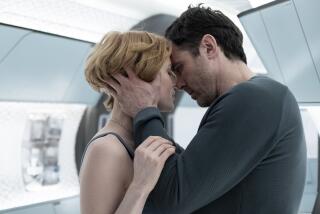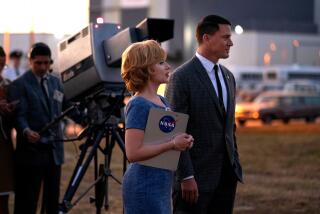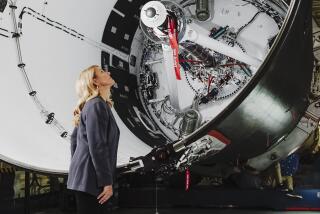From the Archives: Our original film review of ‘The Right Stuff’ holds clues for John Glenn’s path to senator
John Glenn, astronaut, senator and the first U.S. citizen to orbit Earth, passed away Thursday at 95. In Philip Kaufman’s film “The Right Stuff,” based on the book by Tom Wolfe, Ed Harris plays Glenn. “The ‘clean marine’ with an undiscovered talent for PR,” as then-Times film critic Sheila Benson described Glenn’s depiction in her original review, was at the heart of one of the movie’s most satisfying moments. This review was first published in The Times on Oct. 21, 1983.
----------------
Director/screenwriter Philip Kaufman has reached into Tom Wolfe’s “The Right Stuff,” a hyperventilated account of America’s entry into the space age, and pulled out a plum.
In a brash, beautiful, deeply American film, Kaufman has combined the resources and ingenuity of movie making with the freewheeling, damn-the-conventions style of of the New Journalism and come up with a generous, high-spirited look at the bravery and lunacy that was that era.
The movie’s irreverence will raise more than a few eyebrows, because Kaufman uses anything that works for his Carnival of Astronauts: low comedy, Brechtian savagery and conventions from the most romantic American movies about pilots and flying. Fortunately, all of it, well almost all of it, works; the extraordinary flying footage matches seamlessly with actual NASA documentary work, and the actors seem uncannily true to the spirit of their models.
Like the book, the film lies poised between two ideals of bravery. The most righteous right stuff is the private property of Air Force test pilot Chuck Yeager, played by Sam Shepard in a manner guaranteed to fill the gap created when Gary Cooper left us.
Yeager is the self-sufficient man of the West (and of the last frontier: space), full of repose and distance, yet most certainly not lacking in the juices of life. The movie’s warmest moments are not when an orange-red space capsule hurtles into reentry but when Yeager and his spirited, sultry wife Glennis (Barbara Hershey, relaxed and marvelous) tease and spar with each other at the pilot’s bar before racing home on horseback under a desert moon. It’s the nicest sexuality the screen has had in years, written and played by adults who understand the the voltage of understatement.
In a scene that may be the picture’s emotional highlight, Glenn gives his wife full permission to run L.B.J. off their property.
— Sheila Benson
It’s fortunate that Shepard has as much charisma as he does, because he will bear the brunt of the film’s heavy myth making. Yeager, first man to break Mach I (forget, please, the specious, memorable “Breaking the Sound Barrier”) is in Wolfe’s eyes the pure hero, possibly the only allowable one, and Kaufman, to a lesser degree, indulges in this too.
The real-life astronauts who demand so much of our attention have a hold on rightness, true enough, but theirs is so mixed up with the hoopla and hype of the space program that you feel Wolfe was split between adulation and faint recoil.
The split permeates the film too. It’s obvious that in Shepard/Yeager we have the truest of the true blue, so we slough back to him periodically until he puts his test pilot’s OK on the astronaut’s efforts. They may be “Spam in a can,” lying there in their windowless capsules, but they fly that way knowing the lethal potential of the job. (The scene of astronauts’ revolt until their German spaceship designers give them a window and a hatch they can blow open from the inside is one of the great details of this gorgeous mosaic.)
For the body of the film, however, we are with the astronauts and their wives, whom Kaufman is at some pains to keep as the film’s emotional ballast. He has cast them all brilliantly. Of the fliers, we get to know four chiefly: Scott Glenn as Alan Shepard Jr., first man in space, oscillating between iciness and high school humor; Ed Harris (an actor on the ascendancy this year) is Marine pilot John Glenn, the “clean marine” with an undiscovered talent for PR. The ill-fated Virgil (Gus) Grissom is marvelously played by Fred Ward. And Dennis Quaid as Gordon (Gordo) Cooper — robbed perhaps of his full moment of triumph in the film’s version of his space ride but shortchanged nowhere else in the picture — has a sweet, unshakable sureness.
The remaining astronauts — Scott Paulin as Donald (Deke) Slayton, Charles Frank as Scott Carpenter and Lance Henriksen as Walter (Wally) Schirra Jr. — are each fine, but their characters are barely sketched in for us.
Outstanding among the astronaut wives is Mary Jo Deschanel as Annie Glenn. (She is the real-life wife of the film’s superlative cinematographer, Caleb Deschanel.) Two scenes between Annie, afflicted with a pronounced stammer, and her husband carry the feeling of the astronauts and their wives as a devoted unit. In the most memorable one, Glenn, just off the launching pad from his postponed flight, gets a call from a terrified Annie. L.B.J. (lustily played by Donald Moffat) has served notice that he will arrive at their house to publicly comfort her during this travail. The idea of national television horrifies her. In a scene that may be the picture’s emotional highlight, Glenn gives his wife full permission to run L.B.J. off their property if she doesn’t want him there.
(It’s a satisfying moment, but at the same time there is a hint of the limits of the film as an emotional document if this is the moment that audiences cheer most wildly.)
Funniest is the discovery...at their first press conference that ol’ John (Glenn) has the makings of a silver-tongued and un-shut-up-able orator.
— Sheila Benson
Veronica Cartwright has a vitriolic scene as Grissom’s wife, humiliated and furious when, after Grissom loses his capsule and very nearly his life, she feels that they are given extremely short shrift by the military instead of the perks of a heroic homecoming. It’s a shrewish moment that you wish could be balanced by more insights into the pilots’ quieter, more private moments. But the film has so much to cover that this may just be a forlorn hope.
Pamela Reed has one of the fullest wives’ roles as Trudy Cooper, sturdy enough to take her children and leave the harrowing life at the air base (where 62 men have died in test-flight crashes in 36 weeks) and staunch enough to come back when Gordo needs her for the proper NASA wife-and-family profile.
After their selection, their tests, both painful and humiliating, their work in simulators and in weightless chambers, the astronauts begin to work, not as rival branches of the service, but with a certain grim unity. Best of their moments is the German scientists confrontation, funniest is the discovery by the other six at their first press conference that ol’ John (Glenn) has the makings of a silver-tongued and un-shut-up-able orator.
From the moment the press, “them little root-weevils” in Yeager’s words, are introduced to the seven, the comedy gets lower. And broader. (As played by a commedia dell’arte troupe known as i fratelli Bologna, the permanent press corps seems to have one body and limitless legs, arms and cameras. It is a delicious touch.) The enemies seem to be less the hustling Russians, ahead of us at every turn, than the amazing stupidity of the pols at the top and their minions at the bottom.
Through all of this, the seven fliers’ struggle to be regarded as pilots, not as mere passengers in their crafts, and, indeed to be allowed to fly at all, becomes crucial (NASA sends one chimp ahead of them on a flight).
Finally, we are there, in that incredibly cramped capsule, for two of the astronauts’ triumphs: Shepard’s first American sub-orbital success and the one to pluck up the nation’s spirits, and Glenn’s full-world circles in which the capsule malfunctions (nearly burning up its occupant during re-entry) but the man does not.
Kaufman’s unorthodox choice for his special-effects team produced some of the film’s most amazing flight scenes, the simulation of Yeager’s test flights and the feeling during Glenn’s orbits of the capsule’s true dangerousness and eccentricity. Instead of using the established special-effects houses, Kaufman hired Gary Gutierrez (who did the title sequences for “The Black Stallion” as well as the pre-title sequence in “One From the Heart”) for the majority of the flying effects. (Gene Rudolf is credited as the visual consultant.) And for the view of earth from space and impressionistic views from space, Kaufman chose avant-garde San Francisco filmmaker Jordan Belson. The results are extraordinary and link the flight sequences to some of the equally daring narrative jumps that “The Right Stuff” makes.
Not all the daring works. One notion, involving aborigines during Glenn’s orbit over Australia, is carried one step too far. (The aboriginal actors include David Gulpilil of “Walkabout.”) The link between spiritual astronauts among the aborigines and the spacemen is a wonderful notion, but turning the sparks from their burning ballads into Glenn’s mysterious “fireflies” is a poesy that fails when it becomes so literal. And Royal Dano’s sepulchral figure in black, the ever-present reminder of the pilot’s closeness to death, is another too-fanciful character.
Finally, we are brought full circle to Yeager, intercut as he sneaks up in the skies to try to break the Soviets’ altitude record in that needle-nosed NF-104. His feat of singular bravery is played against an all-stops-out reception for the Mercury astronauts, headed by L.B.J. at the Houston Astrodome, which culminates in a presentation of Sally Rand and her fan dance.
A look passes between the seven men during this fluttering performance, made more lyrical than tawdry, and we can speculate on what it means, but I’m not sure if we have been given the information to read it correctly. Like some of the fliers’ jargon, especially screwing the pooch, it’s something we want to understand, we think we understand, but we may not really have caught precisely.
But there is no missing the closing image, underlying the grace and heroism of the single pilot. It is myth making at its most potent, even though it may undercut the impact of Kaufman’s broad-scale view of the era.
Sign up for our weekly Indie Focus newsletter »
ALSO
Greg Lake —founding member of King Crimson and Emerson, Lake and Palmer — dies at 69
‘Westworld’s’ Ed Harris has had Hollywood success, angered Mickey Mantle and may eye a musical next
John Glenn dead at 95; hero was first American to orbit the Earth
More to Read
Only good movies
Get the Indie Focus newsletter, Mark Olsen's weekly guide to the world of cinema.
You may occasionally receive promotional content from the Los Angeles Times.










